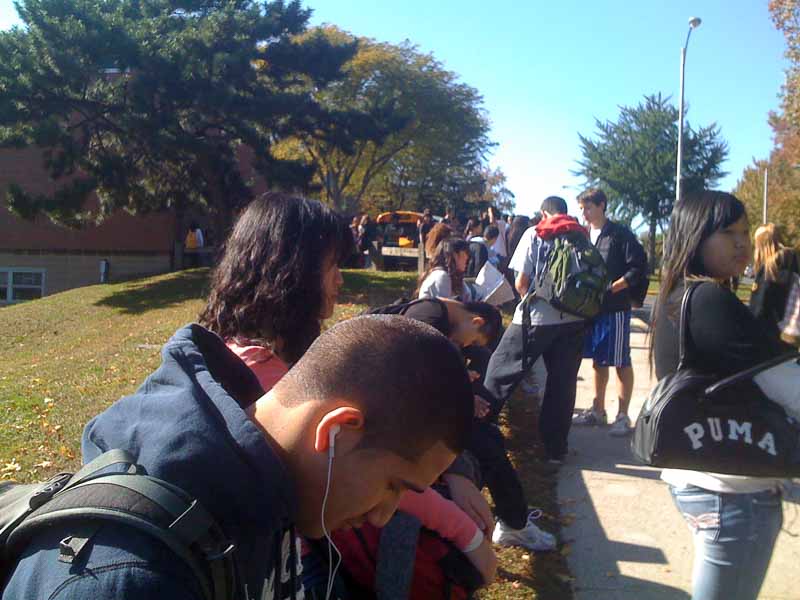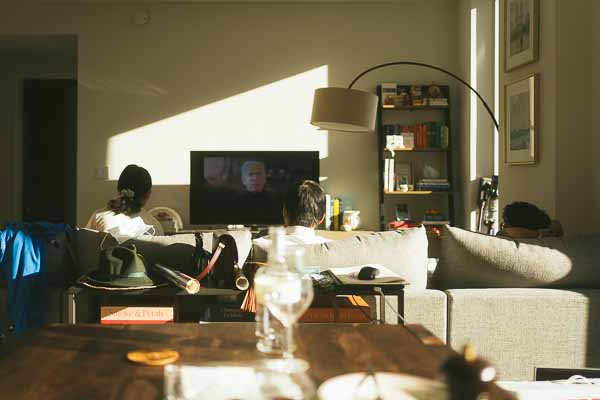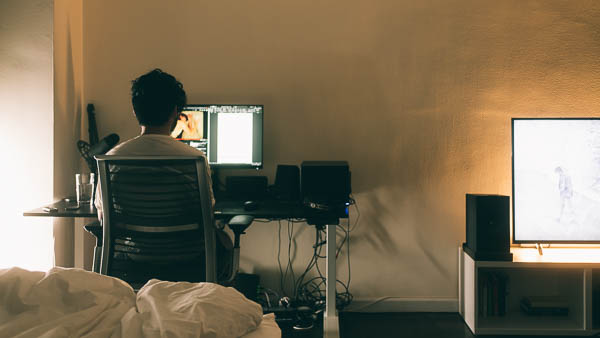Baking Our Own Slice of Life

High school students waiting for a school bus in 2009.
Nostalgia is the new normal. Instead of looking forward to a brighter, limitless future, we look toward the past, toward a time we think we understand, toward a time we wish was normal. But nostalgia itself has changed over time from a serendipitous feeling to a manufactured one, and we can now actively seek out new movies and television shows that evoke nostalgia through a modern lens. We have accepted the unrequited yearning for a familiar-yet-foreign place as normal, rather than ask ourselves why we are so desperate to leave our present. Nostalgia is no longer an illness, but a destination.
What exactly evokes nostalgia? Is it simply the layering of vintage film, forgotten music, and outdated fashion? Yet old clips of soldiers fighting, correspondents narrating, and presidents orating do not directly evoke nostalgia. An element of ordinariness is essential to creating a feeling of nostalgia because we relate the most to those everyday moments. News is not ordinary. But the act of documenting the extraordinary events of our lives will inevitably sweep up bits of the zeitgeist. Home videos that predate us can feel nostalgic because they tap into the collective memory that we’ve been taught, as well as the shared human experiences of parenting and growing up. Old photos submitted to the OldSchoolCool subreddit also have a similar effect, not only drawing on our pre-existing notions of “cool”, but expanding it by juxtaposing photos from different eras in one stream. Nostalgia not only asks us to appreciate what we did not appreciate in the moment, but also asks us to appreciate the familiar in the unfamiliar.
Although the term “slice of life” predates anime by about a hundred years, it has evolved into a genre unto itself, seeking to not only depict, but also cherish the mundane. By stripping away the narrative, slice of life focuses on the small moments we all share, making them highly relatable to a large audience. One subgenre, iyashi-kei (“healing-type”), further emphasizes this feeling by serving as an escape from the stresses of everyday life. Taking this concept even further, the ImaginarySliceOfLife subreddit showcases solo stills depicting ordinary life in comforting ways, yet devoid of the context that could tie individual pieces together into some greater meaning. In this sense, slice of life aims to evoke a sense of nostalgia for places that we have not visited and time that has not passed.
The authenticity of slice of life work lies in its awareness of a lack of authenticity. Hayao Miyazaki, the famous co-founder of Studio Ghibli states that “the animator must fabricate a lie that seems so real, viewers will think the world depicted might possibly exist.” Many slice of life anime have fantastical elements, such as magic or monsters, that are treated as ordinary in the fantasy world. This reinforces the escapist aspect of nostalgia that we yearn for and distracts us from the pain of knowing that we can never revisit those moments again. It is the view of life through rose-tinted glasses.
A similar sentiment is evoked through the cottagecore community on Instagram, an aesthetic that strives to romanticize the English countryside before industrialization. According to one teen in the New York Times, “it’s like Animal Crossing but in real life.” Like iyashi-kei anime, “cottagecore is less about a lifestyle and more about the longing for it, the yearning that maybe things would feel different if they looked a little prettier.” Yet an actual cottagecore life is undeniably dirtier than an urban one, as plants and animals have needs beyond being subjects of photoshoots. As in anime, cottagecore only exists as a place on our screens.
The absence of dramatic narrative and concrete details that could tie a work to the real world (or even a fantasy world) allows us to identify as one of the characters, like the cute girl in “lofi hip hop radio – beats to relax/study to”. Details such as the MacBook-like laptop and over-ear headphones ground the background image firmly in the modern era, but unlike a Hollywood film, the plot never advances, even as day turns into night. The lofi beats are “infamous – precisely for their undifferentiated sound,” yet achieve the same soothing effect on every listener. It’s remarkable how music we’ve never heard, from a genre only invented recently, can induce “sonic nostalgia.” Perhaps its simplicity is what allows us not only to relax, but to find what we are looking for.

Fishing in Animal Crossing: New Horizons.
To participate in a slice of life world, just play the quintessential slice of life game series, Animal Crossing. There is no end goal, so the tedious tasks that would ordinarily gate players from advancing the plot in other single-player games are at the forefront. Yet the lack of narrative means there is no tension, no rush to accomplish the goals that have not been set. It allows us to relax by elevating the tedium of picking weeds and joy of buying clothes to the greatest pleasures known to the villagers that inhabit the town. As one blogger writes, “it’s a window to an imaginary slice of life where the present is a gift to be enjoyed.” But perhaps most uniquely, it permits us the feeling of innocence, because no matter what we do in the game, nothing can go wrong.
If picking cherries in Animal Crossing: New Horizons is too much work, we could instead relax to a vlog about preparing cherry confections. In its most basic form, a vlog is a literal slice of life of the vlogger, condensed into a short video. It allows us to relate our ordinary lives to the ordinary lives of other people, even if they are only similar in the most superficial of ways. We overlook the artificiality of vlogs because we “crave illusion” in our quest to find comforting distractions. What vlogs provide that games and illustrations do not is a sense of connection between the viewer and the vlogger. The unavoidable details inherent in filming mundane tasks every day create a feeling of intimacy that even close friends rarely get to experience, yet a vlog is still a “form of escapism” for viewers.
The YouTuber Casey Neistat restarted vlogging after a long hiatus, remarking in a new vlog that he started making videos again because “when I look back at the first vlog I posted five years ago it's like such an intimate portrait of what my life was like then. It's fascinating to see that and right now it feels like such a big transitional part of my life that to be able to capture it even a little bit with like a five minute video that's exciting for me.” For the vlogger and long-time followers, the vlog is a time capsule of not only the vloggers activities, but also their feelings. But viewers are yearning for a relationship that only exists on one side, and for a person that only exists through the careful filming and editing of the vlogger.
“The effortlessness of Neistat’s vlog is an illusion,” according to a video essay from Nerdwriter. Even as Neistat actively breaks conventional filmmaking rules with his lack of polish, his goal has always been to “create a good or entertaining piece of content every day.” The authenticity in his work is driven by the authenticity of purpose, not by trying to be authentic via performative transparency. It is impossible to pretend to be down to earth while actively hawking products that were provided for free – it is no longer a slice of life that viewers can relate to.
Ultimately vlogs are too grounded in storytelling to allow us to inhabit the lives of our favorite vloggers. They cultivate sympathy for the trials and joys of their life at the time, but struggle to cultivate empathy because vlogging itself is not relatable. It takes a lot of effort to vlog like Casey Neistat, so most of us just take photos. Yet our albums rarely capture a slice of life feeling because we tend to document the exceptional rather than the mundane. Perhaps this is why the performative vulnerability of lifestyle Instagrammers fails to resonate with us – it is not authentic to be so exposed online. Self-promotion is not intimate.

Friends hanging out.
Like the illustrations in the Imaginary Slice of Life subreddit, the work of Edward Hopper depicts the ordinary, but with a stark minimalism rather than a familiar kitschiness. Rather than coating his subjects in innocence like in anime, they are wrapped in an isolation that is both relatable and lonely. This feeling is inspiring to street photographer Jason Kummerfeldt who wants “to take ordinary scenes and make them beautiful and make the audience want to jump in and be a part of them.” Yet Hopper’s scenes, though realistic, tend to exaggerate or omit details that would be present in a photo. His illustrations “focussed on the material memory of the city” – the way we want to remember a place rather than how it was.
Hopper’s work is nostalgic even though he “tried very hard to unmoor his work from the historical moment,” unlike Stranger Things, which that emphasizes the details of the 80s to remind viewers of when the show is set. Combined with the fantastical nature of slice of life anime, this puts forth the idea that nostalgia can be created through physical rather than temporal distance, like contemporary Britain in photography by Ian Howorth. In an interview with Willem Verbeeck, he summarizes that his photos are “like an empty space that you fill, you know, with whatever you want, you know, your past experiences, your emotions” and that the binding element of his photography “is that feeling of being alone.” Even though much of his works are shots of older automobiles and architecture without people, the tranquility he seeks reminds us that nostalgia is a feeling that we often experience by ourselves.
Street photography distinguishes itself from photojournalism through its focus on aesthetics, even though they are both authentic in their candidness. Aesthetics are crucial to nostalgia because the emotional reaction must overtake the rational context that noteworthiness requires. Yet the voyeurism of street photography precludes it from becoming escapism. We struggle to immerse ourselves into a photo of strangers because we ourselves may be the strangers in a photo. Street photography is the reflection of ourselves we do not want to acknowledge.
If street photography is the ultimate in candidness, cinematography is the ultimate in constructedness, at least from behind a lens. Through masterful use of practicals and silhouettes, Roger Deakins fools us into believing that the narrative of a film is simply a slice of the character’s life, and by watching the film we are escaping our lives into theirs. Cinematographers have mastered the art of creating unreality within reality, suggesting that we should believe that film created in our world was authentically created in another. This idea is clearest in still frames taken from completed films. Even though every frame is meticulously populated by actors, extras, the work of set designers and lighting directors and myriad creatives, the still asks us to consider those moments between plot points. It reminds us that the B-roll of a movie, like the mundane parts of our lives, is critical to understanding the story.
For a photo to capture a slice of life, it must deemphasize the subject in the frame and allow the viewer to immerse themselves within the image. It must create a sense of intimacy, a vulnerability that is intensely relatable, perhaps by being in a private space or one that is vaguely familiar. It must inspire a sense of escape for the viewer, the nostalgic unreality within reality, perhaps with otherworldly lighting. It must be mundane, the easy-to-forget aspect of life, to avoid drawing attention to why the photo exists at all.
I found one work by an American artist depicting a girl lit by sunlight and sitting in bed to be remarkably similar to a photo taken earlier that month by a Japanese photographer. I do not know if the illustration was inspired by the photograph, but they each seem to capture the essence of contemplation. Although the photo seems ordinary at first glance, a closer inspection reveals an empty glass bowl in front of her, a flower on her back, and a dark curtain that transitions into a bedsheet. Is the bed even a bed? The photo is full of artifice yet is immediately relatable.
Why is it worth trying to capture slices of our own lives when we can empathize with the works of artists instead? Photography is one way of actively appreciating the present since it forces us to pay attention to what we see. The choice of what we do and do not photograph reflects not only the feelings of what is in the frame, but the feelings of the person behind the camera. Not only are we capturing a scene as we want it to be seen, but we are projecting our feelings into the image. As one photography curriculum states: “one can say photography is a physical manifestation of mindfulness.”
I am reminded of the closing act in a vlog by Casey Neistat where he browses a fifteen-year-old album of family photos for his favorite. In the one he picks, he is resting his head on the lap of his now-wife with their backs to the camera. Even though they are not together yet, they seem to be in love. Perhaps it was a performative moment for the camera, but performing our feelings is one way of living in the moment. Like the B-roll shots in a film, the personal photos we cherish the most are the ones that happen to capture a slice of our lives.

Writing this essay.